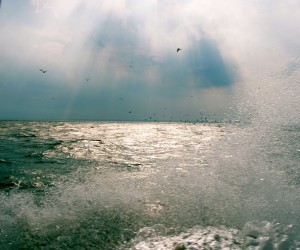menhaden
I could hear the excitement in my fishing partner, Jamie Clough’s voice as he scanned the cloudy Chesapeake horizon with his binoculars.”
“Big birds!”
I slammed my 27′ Judge Center Console into gear and Thunder Road was off to the races. Up ahead, through the misty rain, we could see big herring gulls as they swooped and circled high over the water. As if on cue, a group of six or eight birds plunged toward a swirl on the surface. A savage fight ensued and the victor flew away erratically as the other gulls gave chase. In the lead bird’s beak was a 6-inch long silver fish.
“They’re on big bunker. That’s what we’re looking for,” shouted Jamie.
We bolted toward the spot where the birds were diving with our rods and reels at the ready. Before the boat came to a complete stop, we were both hooked up.
“Fish on!”
How was your fishing this fall? By most accounts, it’s been a great season for light tackle casting on the Chesapeake Bay. One of the reasons why we’re catching more fish than ever this year is that, thanks to recent harvest reductions, there is a lot of bait around, especially menhaden. In the Chesapeake, anglers refer to menhaden as bunker or sometimes (incorrectly) LYs. They’ve famously been called, “the most important fish in the sea.” That’s because menhaden are such a critical link in the Atlantic’s food web. At one time, menhaden made up over 70% of rockfish diets. Now, that number has dwindled to something like 8% because there just isn’t enough menhaden to keep the rockfish fed. In fact, the population of menhaden in the Atlantic Ocean is at less than 10% of historic levels. That’s a big drop and a huge problem, not only for recreational fishermen, but for anyone who makes their living in and around the Bay. Read More!
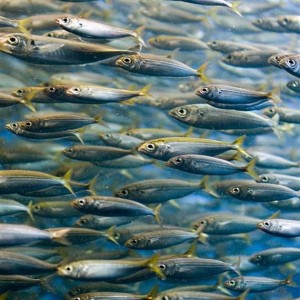 Next Monday, December 8th, the Mid-Atlantic Fisheries Management Council (MAFMC) meets in Baltimore to discuss an ecosystem approach to fisheries management. This meeting will include a session to consider potential action to protect unmanaged forage fish in areas outside the territorial three-mile line. This is the area where they are most likely to be harvested. When we think of forage fish, we usually think of menhaden. That’s because most fishermen are aware of steep declines in their numbers, but forage fish also includes other bait species like glass minnows, bay anchovies, silversides, grass shrimp, river herring, white shad, hickory shad, sand eels, and hundreds of others. While a few of these species are managed, albeit poorly, the overwhelming majority are not managed at all. As a result, they are being decimated by commercial fishing fleets.
Next Monday, December 8th, the Mid-Atlantic Fisheries Management Council (MAFMC) meets in Baltimore to discuss an ecosystem approach to fisheries management. This meeting will include a session to consider potential action to protect unmanaged forage fish in areas outside the territorial three-mile line. This is the area where they are most likely to be harvested. When we think of forage fish, we usually think of menhaden. That’s because most fishermen are aware of steep declines in their numbers, but forage fish also includes other bait species like glass minnows, bay anchovies, silversides, grass shrimp, river herring, white shad, hickory shad, sand eels, and hundreds of others. While a few of these species are managed, albeit poorly, the overwhelming majority are not managed at all. As a result, they are being decimated by commercial fishing fleets.
Every good fisherman I know is a conservationist at heart. About a year ago, my friend Trent Zivkovich gave me a copy of A Sand County Almanac by the father of wildlife ecology, Aldo Leopold. This book is considered by many to be the 20th century’s literary landmark for conservation writing. In it, Leopold proposed the “love of sport” as a primary motivation for environmental stewardship. I know from experience that he’s right. It is experience on the water that drives anglers with the right stuff to protect the waters we love and the fish and other animals that live in and around them. Read More!
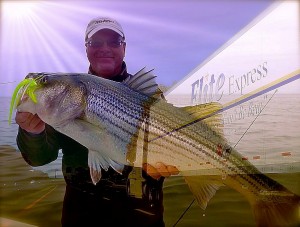 Tell someone where to catch a Chesapeake Bay striped bass and you may help them for a day, but teach them how to identify specific seasonal patterns, and you’ve put them on the express route to becoming an elite fisherman. The fall migratory run is on. This is the time of year when the learning curve drops significantly and stripers feed voraciously. They aren’t too picky about the kind of baits they’ll take and they aren’t as choosy about lure presentation. It’s a great time to learn how to cast lures for big fish. It’s also the time when I step up on my “think patterns, not places” soapbox. Ask any accomplished angler their secret to repeated success and they’ll tell you it’s the ability to identify specific feeding patterns. I believe that you can drop a good fisherman into any body of water in the world and he’ll catch fish as long as you give him enough time to recognize prevailing patterns. Pattern recognition is especially important on the Chesapeake where conditions change quickly. Fortunately, fish are creatures of habit and we can identify predictable characteristics in their behavior.
Tell someone where to catch a Chesapeake Bay striped bass and you may help them for a day, but teach them how to identify specific seasonal patterns, and you’ve put them on the express route to becoming an elite fisherman. The fall migratory run is on. This is the time of year when the learning curve drops significantly and stripers feed voraciously. They aren’t too picky about the kind of baits they’ll take and they aren’t as choosy about lure presentation. It’s a great time to learn how to cast lures for big fish. It’s also the time when I step up on my “think patterns, not places” soapbox. Ask any accomplished angler their secret to repeated success and they’ll tell you it’s the ability to identify specific feeding patterns. I believe that you can drop a good fisherman into any body of water in the world and he’ll catch fish as long as you give him enough time to recognize prevailing patterns. Pattern recognition is especially important on the Chesapeake where conditions change quickly. Fortunately, fish are creatures of habit and we can identify predictable characteristics in their behavior.
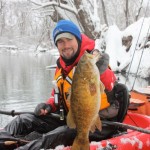
I fished this past Saturday with a new fishing buddy, Jeff Little. You may have heard of Jeff because he’s well-known in the kayak fishing world for his instructional DVDs and videos about smallmouth fishing. Fortunately for Chesapeake Bay fishermen, he’s been bit by the striper bug. I’ve teamed up with him to produce some videos that illustrate my most successful techniques. Stay tuned because we’ll soon be posting one we shot Saturday about striper fishing in the fall on the Chesapeake Bay. We’ll launch a short preview first. If you like it, you can watch the action-packed 30-minute version for just $2.49. Read More!
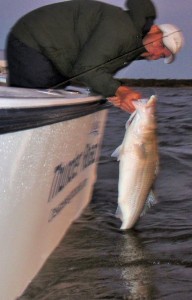 Since I’ve reported bigger fish on recent trips, I’ve been overwhelmed with questions from fishermen who want to know where the fish are. The big fish are moving around very quickly and they are rarely at the same place twice. Even on days when I find them right back where I left them, they’ve been very wary and hard to catch. It’s been a challenging season, but if you look at my mid-October fishing reports from last year, you’ll see that the pattern is nearly the same. I think we sometimes put too much emphasis on locations, and not enough on patterns. Tell someone where to go to catch a fish and you may help them for a day, but teach them how to identify specific patterns in how fish behave, and you’ve helped them for a lifetime. Ask any accomplished fisherman the secret to repeated success and he’ll tell you it’s the ability to identify specific feeding patterns. I believe that you can drop a good fisherman into any body of water in the world and he’ll catch fish as long as you give him enough time to recognize the prevailing pattern. It’s especially important on the Chesapeake where circumstances change quickly and rapid drops in water temperature are not unusual in October. I think fishing conditions shift faster and more often here than anywhere I’ve fished before. Fortunately, fish are creatures of habit and there are distinct patterns to their behavior.
Since I’ve reported bigger fish on recent trips, I’ve been overwhelmed with questions from fishermen who want to know where the fish are. The big fish are moving around very quickly and they are rarely at the same place twice. Even on days when I find them right back where I left them, they’ve been very wary and hard to catch. It’s been a challenging season, but if you look at my mid-October fishing reports from last year, you’ll see that the pattern is nearly the same. I think we sometimes put too much emphasis on locations, and not enough on patterns. Tell someone where to go to catch a fish and you may help them for a day, but teach them how to identify specific patterns in how fish behave, and you’ve helped them for a lifetime. Ask any accomplished fisherman the secret to repeated success and he’ll tell you it’s the ability to identify specific feeding patterns. I believe that you can drop a good fisherman into any body of water in the world and he’ll catch fish as long as you give him enough time to recognize the prevailing pattern. It’s especially important on the Chesapeake where circumstances change quickly and rapid drops in water temperature are not unusual in October. I think fishing conditions shift faster and more often here than anywhere I’ve fished before. Fortunately, fish are creatures of habit and there are distinct patterns to their behavior.
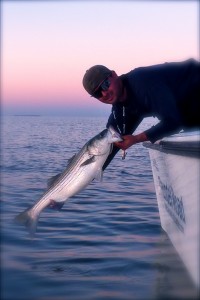 Since I’ve been reporting bigger migratory fish on my recent trips, I’ve been overwhelmed with questions about where the fish are. My apologies if I’ve yet to return a call or answer an email, but the absolute truth is – I don’t know. These big fish are moving around very quickly and they haven’t been at the same place twice. I think we sometimes put too much emphasis on locations, and not enough on patterns. Tell someone where to go to catch a fish and you may help them for a day, but teach them how to identify specific patterns of how fish behave, and you’ve helped them for a lifetime. Ask any good fisherman the secret to repeated success and he’ll tell you it’s the ability to distinguish specific feeding habits. I believe that you can drop a good fisherman into any body of water in the world and he’ll catch fish as long as you give him enough time to establish a prevailing pattern. It’s especially important on the Chesapeake where conditions change quickly and a rapid thirty degree temperature drop in October is not unusual. I think fishing conditions change faster and more often here than anywhere I’ve fished before. Fortunately, fish are usually creatures of habit and there are distinct patterns we can identify in the way they behave. Read More!
Since I’ve been reporting bigger migratory fish on my recent trips, I’ve been overwhelmed with questions about where the fish are. My apologies if I’ve yet to return a call or answer an email, but the absolute truth is – I don’t know. These big fish are moving around very quickly and they haven’t been at the same place twice. I think we sometimes put too much emphasis on locations, and not enough on patterns. Tell someone where to go to catch a fish and you may help them for a day, but teach them how to identify specific patterns of how fish behave, and you’ve helped them for a lifetime. Ask any good fisherman the secret to repeated success and he’ll tell you it’s the ability to distinguish specific feeding habits. I believe that you can drop a good fisherman into any body of water in the world and he’ll catch fish as long as you give him enough time to establish a prevailing pattern. It’s especially important on the Chesapeake where conditions change quickly and a rapid thirty degree temperature drop in October is not unusual. I think fishing conditions change faster and more often here than anywhere I’ve fished before. Fortunately, fish are usually creatures of habit and there are distinct patterns we can identify in the way they behave. Read More!
Rich joined me for an exploratory trip to the mid-Bay Sunday evening. We launched Crockett’s Reel off Kent Island, passed on some small blitzing fish in the Eastern Bay, cut through Poplar Narrows, and started fishing just north of Sharps Island Light. It was dish calm so we could see anything that moved on the surface. There was lots of bait, plenty of young gulls skimming rain minnows, and some isolated pods of very large bunker. We found several schools of breakers consisting of small blues and dink rockfish. As we moved farther south, we caught heavier blues but we had a tough time finding anything any size with stripes. We need 2-4 inch menhaden (peanut bunker), but I haven’t seen too many since spring. Hopefully there are some in the rivers but bait that size has been rare this year. Read More!



